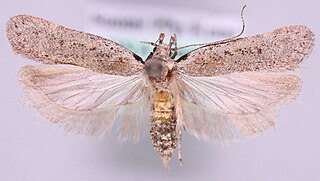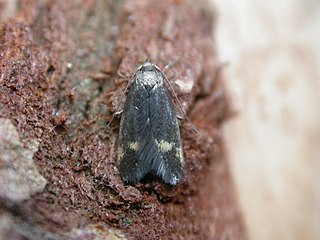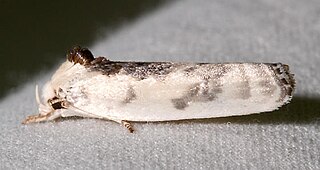Related Research Articles

Chionodes is a genus of moths of the family Gelechiidae. It is distributed throughout much of the world. The larvae of many species use the Douglas fir as a host plant.

The Lecithoceridae, or long-horned moths, are a family of small moths described by Simon Le Marchand in 1947. Although lecithocerids are found throughout the world, the great majority are found in the Indomalayan realm and the southern part of the Palaearctic realm.

Dichomeris is a genus of moths in the family Gelechiidae erected by Jacob Hübner in 1818.

Gelechia is a genus of moths in the family Gelechiidae. The type species is Gelechia rhombella.

Glaucocharis is a genus of moths of the family Crambidae described by Edward Meyrick in 1938.

Lecithocera is a genus of moths in the lecithocerid subfamily Lecithocerinae. The genus was erected by Gottlieb August Wilhelm Herrich-Schäffer in 1853.
Ithome is a genus of moths in the family Cosmopterigidae.
The Eucosmini are a tribe of tortrix moths.

The Depressariinae – sometimes spelled "Depressiinae" in error – are a subfamily of moths in the superfamily Gelechioidea. Like their relatives therein, their exact relationships are not yet very well resolved. It has been considered part of family Elachistidae sensu lato or included in an expanded Oecophoridae. In modern classifications they are treated as the distinct gelechioid family Depressariidae.

Borkhausenia is a genus of the concealer moth family (Oecophoridae) described by Jacob Hübner in 1825. Among these, it belongs to subfamily Oecophorinae, wherein it is probably closely related to Hofmannophila. In the past, several other Oecophoridae have been included in Borkhausenia, as well as a few even more distant members of the superfamily Gelechioidea. Metalampra was originally described as a subgenus of Borkhausenia. Telechrysis has also been included here as a subgenus by some, while other authors have considered it a separate genus in the Oecophorinae or – if these are also considered distinct – the Amphisbatinae.

Antaeotricha is a genus of moths. It is the largest genus in the subfamily Stenomatinae, numbering over 400 species in the Western Hemisphere.

Caloptilia is a genus of moths in the family Gracillariidae.

Acrocercops is a genus of moths in the family Gracillariidae.

Gelechiinae is a subfamily of moths in the family Gelechiidae. It was described by Henry Tibbats Stainton in 1854.

Stenoma is a genus of moths. The type species is Stenoma litura, which was described by Philipp Christoph Zeller in 1839.
Chlamydastis is a genus of moths in the subfamily Stenomatinae.
Doina is a moth genus of the family Depressariidae.

Llollelhue River is a river in south-central Chile. It originates near Futrono in the vicinities of Ranco Lake and flows then in a general southwestern direction until discharging in Bueno River. The city of La Unión and the locality of Daglipulli are located on its western bank.
References
- ↑ Savela, Markku. "Doina scariphista (Meyrick, 1931)". Lepidoptera and Some Other Life Forms. Retrieved August 14, 2019.
- ↑ Clarke, J. F. Gates (1978). "Neotropical Microlepidoptera, XXI: New Genera and Species of Oecophoridae from Chile" (PDF). Smithsonian Contributions to Zoology (273): 34.